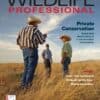Share this article
ISSUE STATEMENT: CONSERVATION POLICY FOR AT-RISK SPECIES IN CANADA
Back to Position Statements page
Canada’s Species at Risk Act (hereafter, SARA) was enacted in 2002 to support Canada’s federal government in the role of preventing wildlife extinctions and ensuring the recovery of at risk wildlife in Canada. Over 640 species of plants and animals were listed under SARA as wildlife species at risk, where at risk includes Schedule 1 species classified as being either extirpated, endangered, threatened, or of special concern. Once listed, the measures to protect and recover a listed wildlife species are developed for implementation. Where population trends can be accurately assessed, data show that some SARA-listed and vulnerable species are continuing to decline (some to the extent that they have entered a higher risk category), and others are experiencing little to no progress towards established recovery goals (Office of the Auditor General of Canada 2023).
Six of Canada’s 13 provinces and territories do not have legislation specifically directed at at risk species conservation. Even where provincial/territorial legislation exists, implementation directives are typically spread across multiple government agencies with varying mandates and authorities, posing significant coordination challenges (Ray et al. 2021).
The National Accord for the Protection of Species at Risk formalized an agreement between
Canada’s federal and provincial/territorial governments to coordinate protection and management of at risk species across most provinces and territories. Under the Accord, governments agreed to develop complementary legislation, regulations, policies and programs to identify and protect threatened and endangered species and their critical habitats. The Accord established the Canadian Endangered Species Conservation Council to coordinate actions and serve as a forum for resolving any disputes. The Council is made up of federal ministers of Environment, Fisheries and Oceans, and Heritage and the provincial and territorial ministers with responsibilities for wildlife species. The province of Quebec is not a signatory of the Accord but works in complementarity with the federal government in setting priorities for the recovery of species.
The principles and strategies outlined in the 2018 Pan-Canadian Approach to Transforming
Species at Risk Conservation in Canada establish a further commitment between the federal
government, provinces, and territories to build a complementary National Framework for multispecies and multi-ecosystem recovery planning based on shared priorities for meeting species at risk requirements to the greatest extent. This approach also emphasizes the engagement and leadership of Indigenous communities in reversing the decline of species, recognizes the changing climate impacts on conservation efforts, and pursues investment in collaborative management.
The policy of The Wildlife Society regarding at-risk species conservation policy in Canada is to:
- Encourage the creation and implementation of specific legislation and policies to manage at-risk species in those provinces and territories where this type of legislation does not
currently exist; - Advocate for funding and resources at the federal and provincial/territorial levels to address the backlog in critical habitat designation and species recovery planning currently
identified under SARA; - Engage proactively with legislative and policy proposals at both the federal and provincial territorial levels addressing landscape-level conservation of species’ habitats;
- Recognize and support the role of Indigenous peoples and communities, in achieving
species recovery and conservation goals; - Promote the use of best-available science and other evidence to inform listing, recovery
planning, mitigation, and critical habitat designation under SARA and territorial and provincial at-risk species legislation; - Encourage the incorporation of climate change considerations into decision-making
affecting at-risk species and ecosystems; - Support efforts to increase collaboration between federal, provincial, territorial governments and Indigenous peoples in identifying, prioritizing, and implementing policies and management strategies for at-risk species conservation;
- Advocate for efficient and transparent government processes for all activities related to the implementation of policies and management strategies for at-risk species
conservation.
The Wildlife Society’s Position Statement: Conservation of Biological Diversity, states that “The
Wildlife Society supports and promotes global conservation of all components of biological
diversity including species in decline and those at risk of extinction.”
Approved by TWS Council in November 2023.
Conservation Policy For At-Risk Species in Canada Issue Statement PDF







